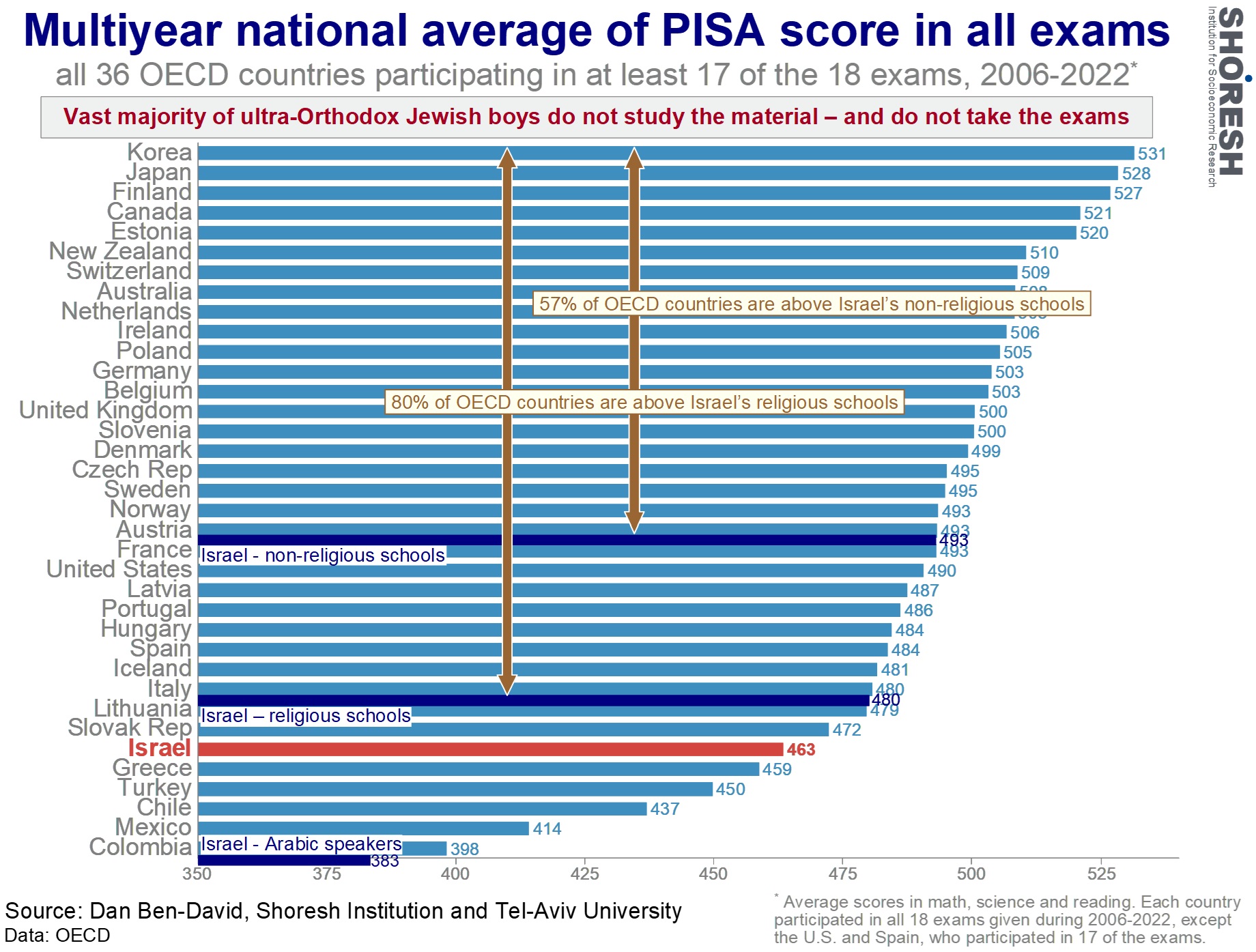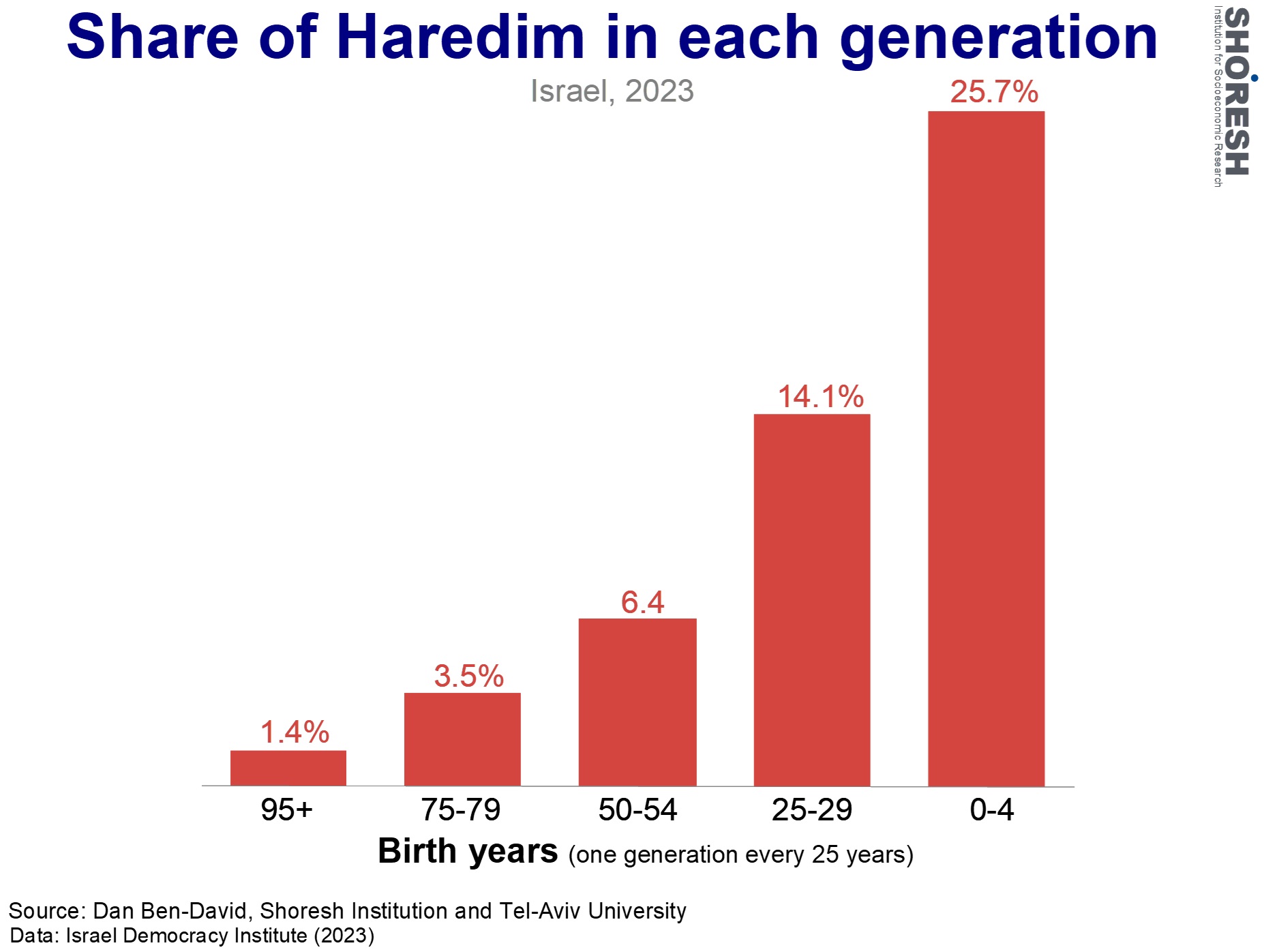|
published
in Israel Hayom on January 1, 2025. An Action Plan to Save Israelís Future by Dan Ben-David With half of its children receiving a third world education and just 20%
of the population paying 90% of the income tax, Israel is staring at an
unsustainable future.† The worst period
in Israelís history provides an opportunity for implementing seemingly
impossible changes that can save the future. A
country surrounded by enemies, where roughly half of the children receive a
third-world education Ė and belong to the fastest-growing segments of the
population Ė will struggle to exist economically, socially, and security-wise
when these children become half, and later the majority, of the adults. The
third-world economy they would be able to sustain wonít support first-world
health, welfare, or security systems. Without an advanced ability to defend
itself in the planetís most violent region, we wonít become a third-world
country. We simply wonít exist. Since
2006, the average achievement level of Israeli children in all PISA exams in
mathematics, science, and reading were below those of all developed nations.
Itís important to emphasize that this low score was achieved without
ultra-Orthodox (Haredi) boys, who do not study the material and do not
participate in the exams. Had they been tested, the national achievement level
would have been even lower.

Students
in Israelís secular schools score below the majority (57%) of OECD countries,
while those in the religious (non-Haredi) schools score below 80% of OECD
countries. The achievement level of Israelís Arabic-speaking students is below
many third-world countries. In the most recent PISA exam, held in 2022, Arabic
speakers in Israel scored below three of the six Arab countries that
participated in the test. Last
year, 22% of Israelís first graders were in Haredi schools, another 22% in the
Arabic speaking schools, with many others in the secular and religious
(non-Haredi) streams studied in Israelís geographical and social peripheries.
In other words, about half of Israeli children Ė belonging to the countryís
fastest-growing population groups Ė are currently receiving a third-world
education. Already today, only 20% of the population pay 90% of the nationís
income a (a slow, but steady, increase from 83% about two decades ago), while
half of the population is so poor that they donít pay any income tax at all. We
need these people. Providing them with a first-world education will not only
benefit them directly, it will also greatly ease the burden on the few who
currently carry it. In
the case of the Haredim, this is a group thatís doubling its share of the
population every 25 years Ė every generation. That is, their share of the
population isnít just growing; itís growing at an accelerating rate. There
arenít many adult Haredim today. They are only 6% of the 50-54 year-old age
group. But this groupís grandchildren, aged 0-4, already constitute 26% of all
toddlers (and in just another 25 years, they will be half of Israelís
toddlers). Tomorrow they will be in school, and on the day after, in the
workforce and the IDF Ė or not. What will happen then depends on what we do Ė
or donít do Ė today.

Thereís
a demographic-democratic point of no return, after which it will be impossible
to pass necessary laws and regulations that are already extremely difficult to
adopt today. But if we donít take advantage of the small public awareness
window that opened during the most terrible year since Israelís birth, we may
no longer be able to change course, and the fate of our children and
grandchildren will be sealed. Below
is the Israel 2.0 Roadmap, followed by an action plan on how to bring Israel
from its current trajectory to one that will be sustainable in the future. To
many, this roadmap will seem unrealistic, and the action plan no less so. But
if we donít begin to focus on and address Israelís root underlying problems,
Israel will cease to exist. Iím counting on the Israeli ability to deal with
anything, to accomplish what seems impossible before itís done (for example,
intercepting the largest ballistic missile attacks in history, a nearly
complete neutralization of Hezbollahís command and control within a day) when
we face the greatest threats together. Israel
2.0 Roadmap 1. The key to national change of direction is a complete overhaul
of Israelís education system. A significant upgrade in the core curriculum
for all Israeli children, with special emphasis on the weaker parts of society.
We need them, and they need the opportunities that will open up for them when
they receive a first-world education. Given the dismal state of the countryís
entire education system, this overhaul should focus on all Israeli children
rather than being directed at the Haredim Ė though it must include all Haredi
children, without exception. 2. An overhaul of budgetary priorities
will incentivize compliance with the education overhaul. As Israel will need to
allocate tens of billions of shekels to restore and restock the army, and tens
of billions more to rebuild the countryís northern and southern regions, and
the lives that were shattered, there wonít be surpluses for sectoral and
personal purposes. This will necessitate, among other things, a complete
cessation of direct and indirect funding (a) for schools that wonít teach the
upgraded core curriculum in its entirety, and (b) for lifestyles of non-work. 3. Reforming Israelís system of government
will enable the implementation of the education and budgetary overhauls. A
government with few ministers, but those who actually understand what their
ministries do. An executive branch with the ability to implement and enforce,
alongside independent legislative and judicial branches, with checks and
balances among all three branches of government. 4. Drafting and passing a constitution
that will firmly entrench the basic rules for the road ahead. While rapid
demographic changes will allow the population in a few decades to undo the
changes in the constitution and the system of government, the hope is that an
upgraded education system in Israel will have done its part during these
decades, and future generations will not want to turn back the clock to the
reality that we currently live in. How can
the Israel 2.0 Roadmap be implemented? In the last elections, about one million
people voted for the Haredi political parties and the political parties headed
by Ben-Gvir, Smotrich, and Maoz. Another half million voted for the
Arab-Israeli parties. Over three million voted for the remaining political
parties, including Likud. Even after excluding the Bibi cult in Likud, thereís
still a solid majority in Israel that understands whatís at stake. The basis
for changing the Titanicís direction requires that this majority stop
quarreling over the placement of deck chair, take the helm, and lead us to safe
shores. To that end, the following work plan is no less ambitious than the
Israel 2.0 Roadmap. An
action plan for implementing the Israel 2.0 Roadmap 1. All opposition leaders must unite in one large across-the-board
umbrella party, a kind of civilian IDF that brings together the full spectrum
of Israeli society to defend the country and save its future. 2. This united party should run on a single platform that is based
solely on the four cornerstones of the Israel 2.0 Roadmap. 3. Full implementation of the Roadmap within the partyís first year in
power. 4. At the end of the first year, dissolve the Knesset, disband the
party, and go to elections under the new system of government. This
is the only way for us to bridge between left and right, religious and secular,
and lead nationwide protests on a scale the country has not yet known Ė
mobilization of the large employers, alongside the masses, to shut down the
economy Ė and put an end to a government leading us straight into the iceberg. Only
together can we steer Israel onto a path that is not just sustainable, but also
a warning to our enemies and a light unto the nations, showing how a democracy
fights for its life and succeeds. Read,
share, and press your leaders to unite with others. Itís on us. ďIf you will
it, it is not a dream,Ē Herzl, round two. |